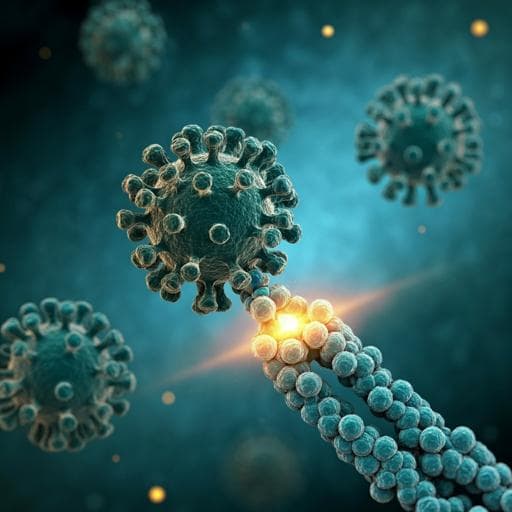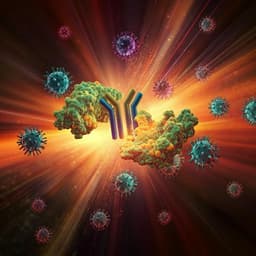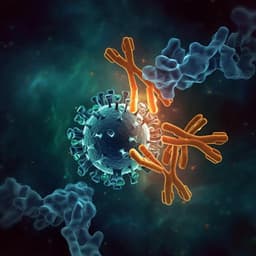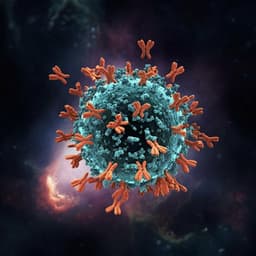
Medicine and Health
A bispecific nanobody dimer broadly neutralizes SARS-CoV-1 & 2 variants of concern and offers substantial protection against Omicron via low-dose intranasal administration
H. Ma, X. Zhang, et al.
This groundbreaking research conducted by Huan Ma, Xinghai Zhang, and colleagues unveils a bispecific nanobody that shows remarkable potency against the latest SARS-CoV-2 variants, providing hope for effective therapies against Omicron. With promising results from animal studies, the future looks bright for preventing COVID-19 infections.
~3 min • Beginner • English
Introduction
SARS-CoV-2 (SARS2) has been spreading for more than two and a half years, causing huge losses to the global economy and human health. In addition to active immunization of vaccines, passive administration of neutralizing antibodies is a promising therapeutic against virus infection. However, continued adaptive evolution has led to variants of concern (VOCs), especially Omicron subvariants, which have evaded most available antibodies and reduced the effectiveness of vaccines designed on the original strain. Prior to SARS2, SARS-CoV-1 (SARS1) emerged in 2002–2003 with higher mortality, and there are currently no approved treatments against it. Thus, ideal countermeasure candidates would be able to effectively treat and prevent both SARS1 and SARS2 and their emerging variants. Both viruses infect humans mainly via ACE2-expressing cells in the respiratory tract, and respiratory viral load correlates positively with disease severity, suggesting that direct delivery of antiviral antibodies to the respiratory tract could achieve efficacy at low doses.
Multivalent engineering (homo- and hetero-multivalency) enhances avidity and neutralization potency and can be more cost-effective than antibody cocktails. Nanobodies (VHHs) are single-domain, thermally resistant, and stable under harsh conditions, facilitating multivalent engineering and development as therapeutics. The authors previously identified a broad-spectrum neutralizing nanobody, aRBD-2, targeting a conserved RBD epitope. In this study, they report a newly identified nanobody, aS3, targeting an RBD core epitope distinct from aRBD-2 and cross-reactive with SARS1, WT SARS2, and major VOCs. Based on aS3 and aRBD-2, they engineered a bispecific dimer (2-3) that neutralizes virtually all VOCs, including BA.5 and the recent BA.2.75, and demonstrate efficacy of Fc-fused formats via intranasal administration at low doses against Omicron in vivo.
Literature Review
The paper situates its work within prior evidence that: (1) passive administration of neutralizing antibodies is effective but challenged by immune escape in emerging SARS-CoV-2 variants; (2) multivalent antibody engineering enhances avidity and neutralization potency and may be more manufacturable than antibody cocktails; (3) nanobodies are advantageous for engineering due to their single-domain nature, thermal stability, and robustness; and (4) a previously identified nanobody, aRBD-2, targets a conserved RBD epitope and exhibits broad binding across variants. These prior insights motivate designing multivalent and bispecific nanobody constructs targeting distinct, conserved RBD epitopes to achieve breadth against SARS-CoV-1, SARS-CoV-2, and VOCs including Omicron sublineages.
Methodology
- Immunization and library construction: Two alpacas were immunized with WT Wuhan SARS-CoV-2 RBD. A phage display VHH library was constructed from peripheral blood mononuclear cells and panned against SARS-CoV-1 RBD for two rounds to isolate cross-reactive nanobodies.
- Lead identification: Nanobody aS3 was selected for tight binding to SARS1 and WT SARS2 RBDs. Competitive ELISA assessed blockade of ACE2–RBD interaction using ACE2-Fc and RBD antigens.
- Binding kinetics: Surface plasmon resonance/Biacore BTx measured binding kinetics and affinities (Kd) of aS3 and Fc-dimerized aS3 (aS3-Fc) to SARS1, WT SARS2, and variant RBDs (including Omicron BA.1, BA.2, BA.5).
- Neutralization assays: Pseudovirus neutralization assays quantified IC50 against pseudotyped SARS1 and WT SARS2. Authentic virus assays included a micro-neutralization test against WIV1 and PRNT against authentic WT SARS2.
- Structural biology: The crystal structure of aS3 bound to SARS1 RBD-tr2 was determined at 3.38 Å by molecular replacement (PDB template 7X41). Structural superpositions with SARS2 spike cryo-EM structures (e.g., PDB: 7mzh) analyzed epitope location and ACE2 clash to explain ACE2–RBD blockade. Interface residues and contact surface area were mapped; sequence alignment inferred corresponding SARS2 RBD contacts.
- Protein engineering: aS3 was Fc-dimerized (aS3-Fc). A bispecific nanobody dimer, 2-3-Fc, was engineered by fusing aS3-Fc with aRBD-2 (which targets a distinct RBD epitope). A variant with a Y296 substitution in aRBD-2 (Y296-3-Fc) was also generated.
- In vivo efficacy: In hamsters, 2-3-Fc was tested for protection against Omicron. A single systemic dose of 10 mg/kg conferred complete protection. Prophylactic intranasal administration at 5 mg/kg drastically reduced viral loads and eliminated detectable virus titers in trachea and lungs (as reported in the abstract).
Key Findings
- Cross-reactivity and binding: aS3 binds SARS1 RBD (Kd 361 pM) and WT SARS2 RBD (Kd 51.9 pM). aS3-Fc further increases affinity to SARS2 RBD (Kd 10.3 pM) and binds SARS1 RBD tightly (reported K0.5 85.4 nM under assay conditions).
- ACE2 blockade and neutralization: aS3 dose-dependently blocks ACE2–RBD interactions for both SARS1 and WT SARS2. It potently neutralizes pseudotyped SARS1 (IC50 2.22 nM; 32.7 ng/mL) and WT SARS2 (IC50 0.97 nM; 14.3 ng/mL). Fc dimerization enhances neutralization potency 22-fold (SARS1) and 3-fold (WT SARS2) on a molar basis, with aS3-Fc IC50 values of 0.10 nM (0.81 ng/mL) for SARS1 and 0.36 nM (29.0 ng/mL) for WT SARS2.
- Authentic virus activity: aS3-Fc neutralizes authentic WIV1 (IC50 1.04 nM; 83.7 ng/mL) and authentic WT SARS2 by PRNT (IC50 0.34 nM; 27.4 ng/mL).
- Variant coverage: aS3-Fc retains binding to RBDs of Alpha, Beta, Gamma, Kappa, Lambda, Delta, and Delta plus; binding is reduced to Omicron BA.1, BA.2, BA.5. SPR shows Omicron RBD Kd values of ~1.84–2.37 nM (approximately 200-fold weaker vs WT), consistent with decreased interactions near S371/S375 mutations but minimal reliance on positions mutated in earlier VOCs (K417, L452, T478, E484, F490, N501).
- Structural mechanism: Crystal structure reveals aS3 engages an RBD core epitope (surface area ~877.8 Å2) involving FR2, CDR2, and CDR3, contacting residues on SARS1 RBD (e.g., L355, Y356, S358, F361, S362, T363, F364, K365, C366, Y394, R395, L498, G490, Y494). Epitope mapping and alignment explain cross-reactivity with SARS2 (e.g., L368, Y369, S371, F374, S375, T377, K378, G379, V407, R408, V503, G504, Y508). Steric clash of aS3 FR2 with ACE2 accounts for ACE2 blockade.
- Bispecific nanobody dimer: 2-3-Fc (aS3 fused with aRBD-2) shows single-digit ng/mL neutralizing potency across major VOCs, including BA.5.
- In vivo protection and intranasal efficacy: In hamsters, a single systemic 10 mg/kg dose of 2-3-Fc provided complete protection against Omicron. Prophylactic intranasal administration at 5 mg/kg drastically reduced viral loads and eliminated detectable virus titers in trachea and lungs.
- Improved activity against BA.2.75: Y296-3-Fc, carrying a Y296 substitution in aRBD-2, outperformed 2-3-Fc against BA.2.75.
Discussion
The study addresses the urgent need for countermeasures resilient to immune escape in SARS-CoV-2 VOCs by targeting conserved RBD epitopes using nanobody engineering. aS3 binds a conserved RBD core epitope distinct from the RBM-targeting aRBD-2. Their combination in a bispecific dimer (2-3-Fc) leverages complementary epitopes to increase breadth and potency, achieving strong neutralization against all tested VOCs, including Omicron BA.5. Structural data explain aS3’s cross-reactivity with SARS1 and SARS2 and its ACE2 blockade via steric interference. Although aS3’s affinity to Omicron RBDs is reduced relative to WT, the bispecific architecture compensates and maintains high potency.
Importantly, in vivo data support translational relevance: a single systemic dose completely protects hamsters against Omicron, and low-dose intranasal prophylaxis effectively suppresses and clears virus in the respiratory tract. This aligns with the mechanistic rationale of delivering antivirals directly to the respiratory mucosa where ACE2-expressing target cells are abundant. The findings suggest bispecific nanobody dimers are promising therapeutic and prophylactic agents against both SARS-CoV-1 and SARS-CoV-2, including emerging Omicron subvariants. The Y296 mutation within the aRBD-2 arm further demonstrates the potential to fine-tune breadth against newly emerging sublineages such as BA.2.75.
Conclusion
The authors identified a cross-reactive nanobody, aS3, that binds a conserved RBD core epitope and neutralizes SARS-CoV-1 and WT SARS-CoV-2. Fc dimerization enhances affinity and potency, and structural analyses elucidate cross-reactivity and ACE2 blockade. By combining aS3 with previously characterized aRBD-2 into a bispecific dimer (2-3-Fc), the study achieves single-digit ng/mL potency across major VOCs, including BA.5. In hamsters, 2-3-Fc confers complete protection systemically and demonstrates strong prophylactic efficacy via low-dose intranasal delivery. An engineered variant (Y296-3-Fc) further improves activity against BA.2.75. These results highlight bispecific nanobody dimers as versatile candidates for therapy and prophylaxis against current and future SARS-CoV-2 variants and potentially SARS-CoV-1. Future work should evaluate durability of protection, dosing intervals, safety, and clinical translation of intranasal delivery.
Limitations
- Affinity and binding to Omicron RBDs (BA.1, BA.2, BA.5) are reduced compared with WT, indicating some sensitivity to mutations within the S371–S375 region.
- Structural data presented are for aS3 bound to SARS1 RBD; a high-resolution structure with SARS2 and Omicron RBDs would further validate epitope conservation and binding modes.
- In vivo efficacy is shown in a hamster model; human pharmacokinetics, safety, immunogenicity, and effectiveness of intranasal delivery remain to be established.
- The manuscript excerpt provides limited details on dosing regimens, timing relative to challenge, and breadth of in vivo testing across VOCs; durability of protection and resistance profiling were not detailed in the provided text.
Related Publications
Explore these studies to deepen your understanding of the subject.







